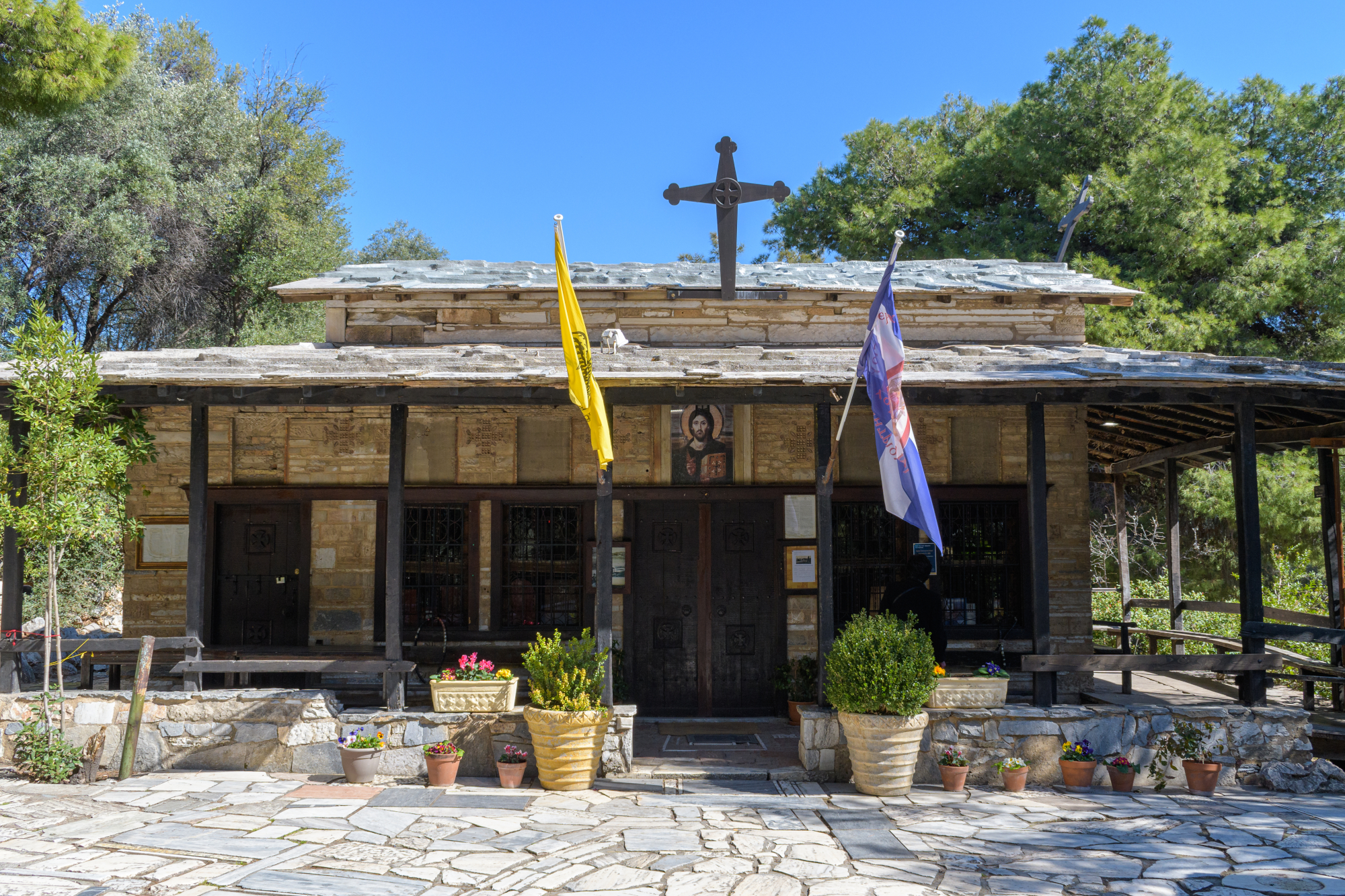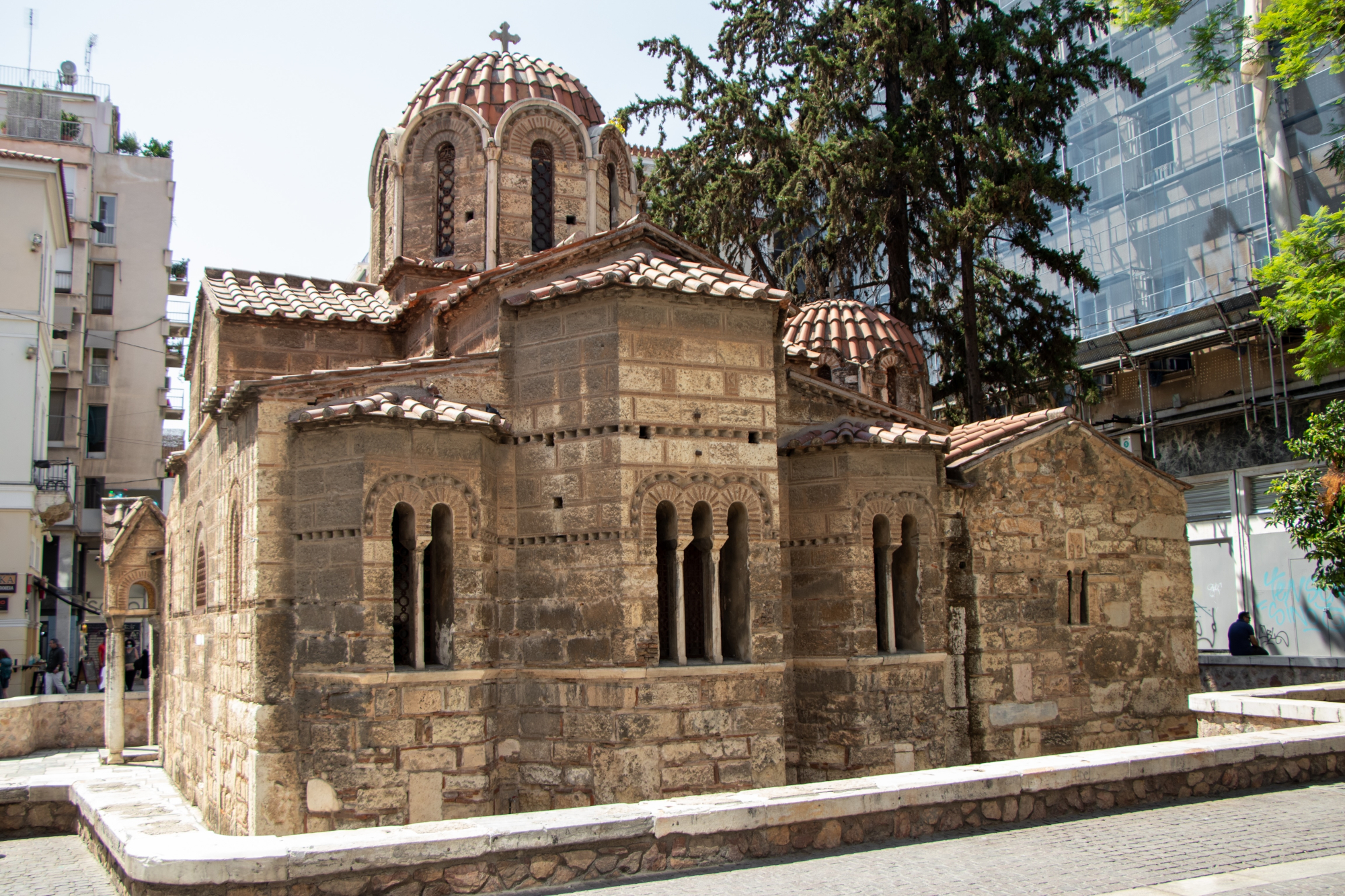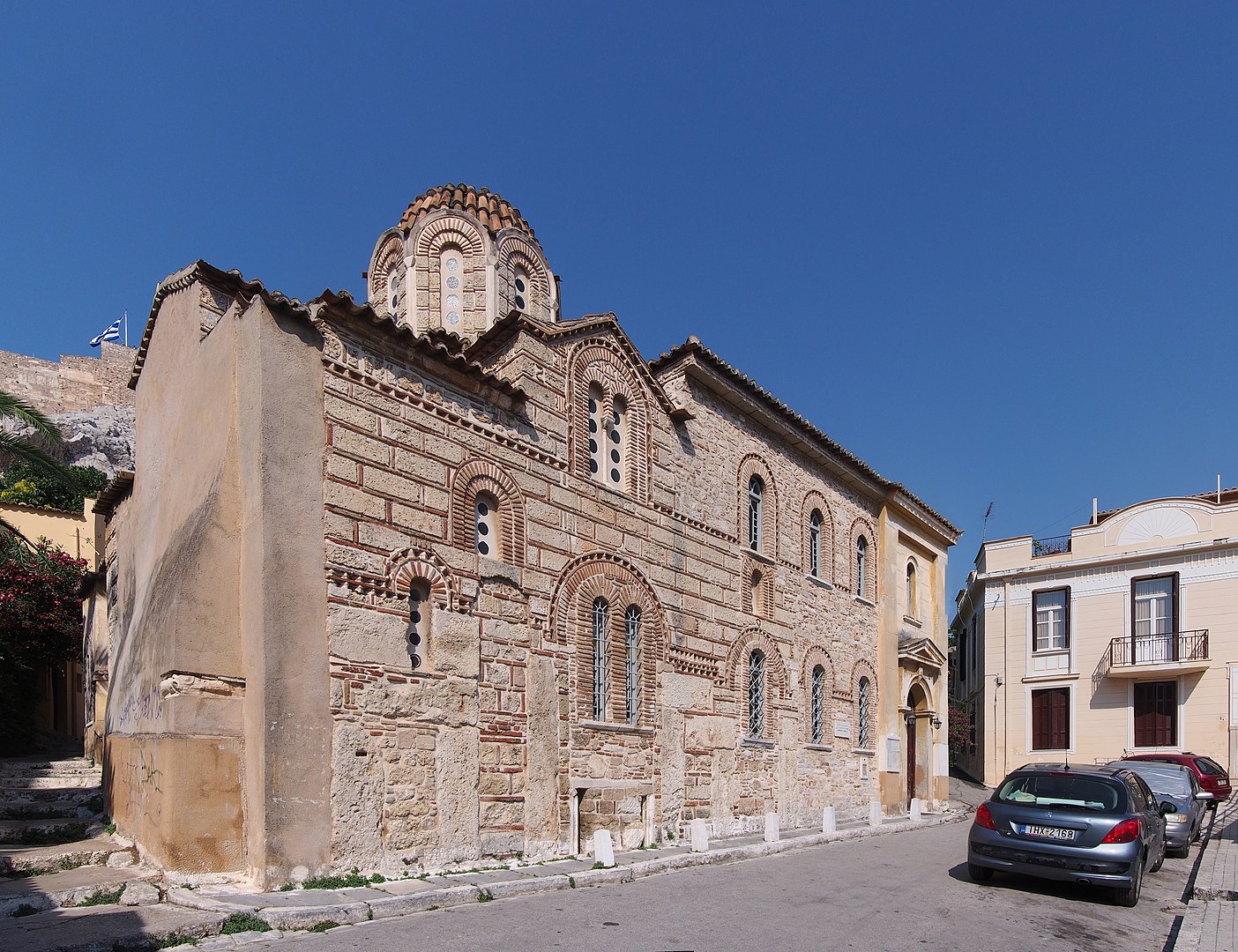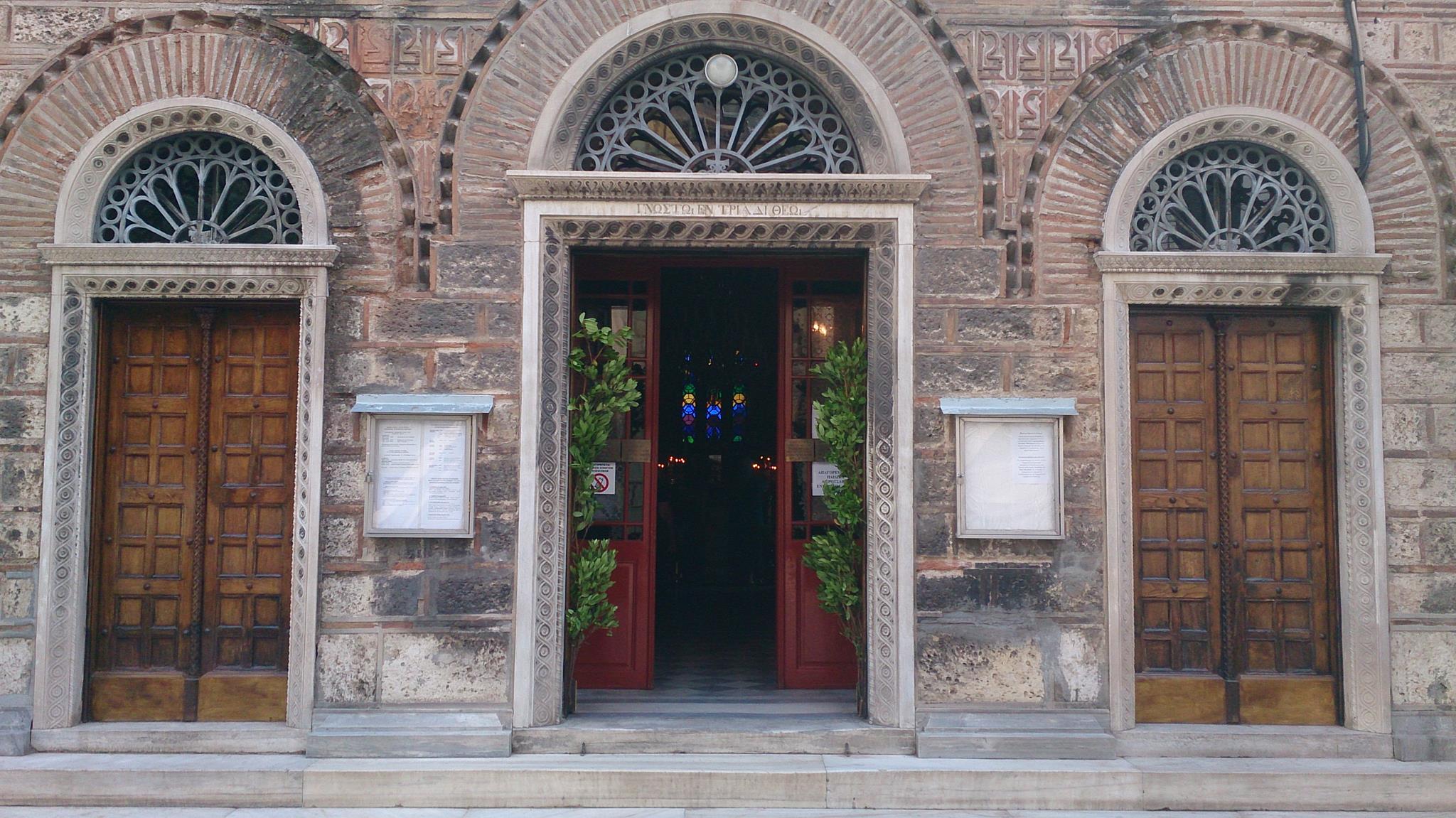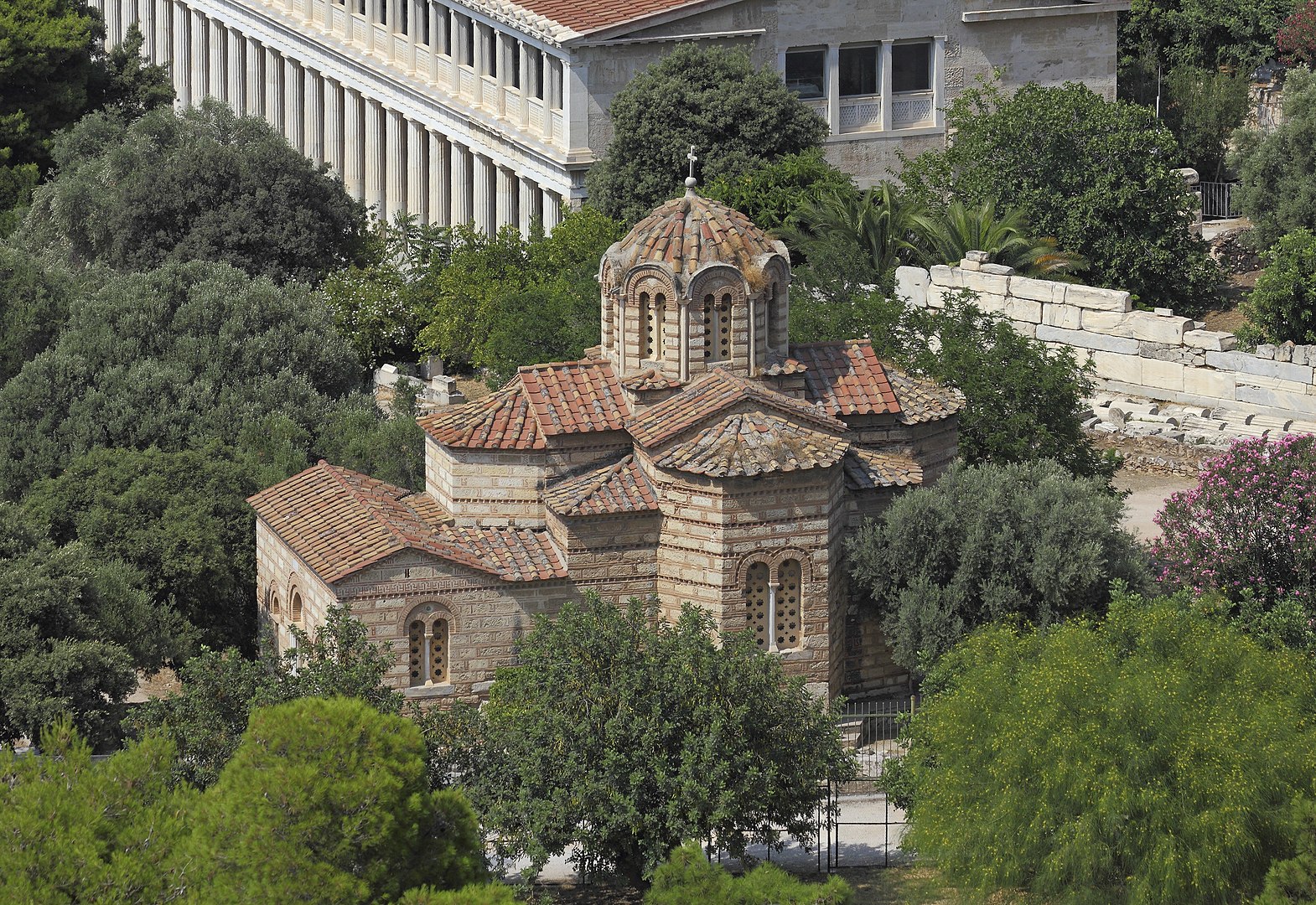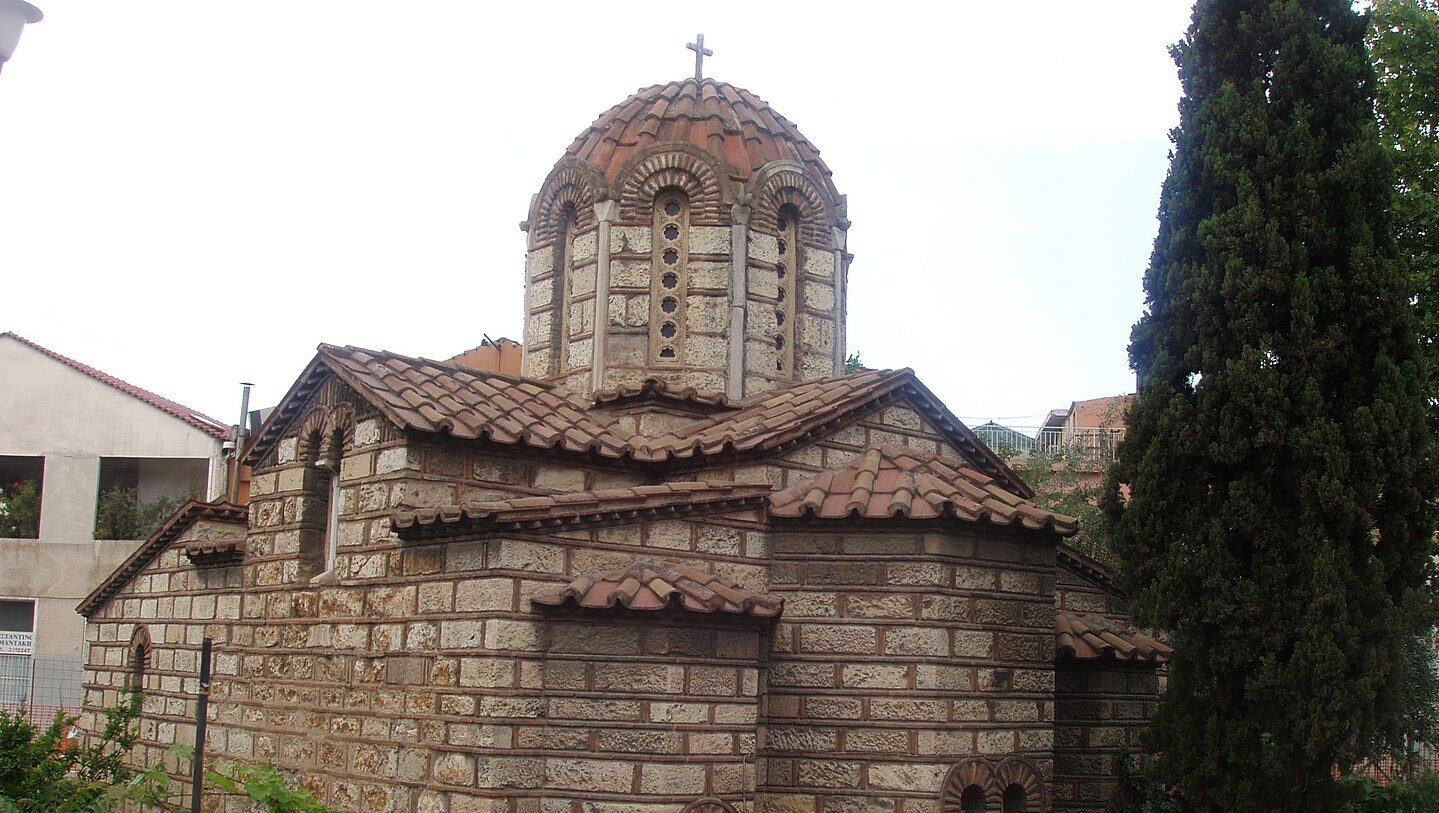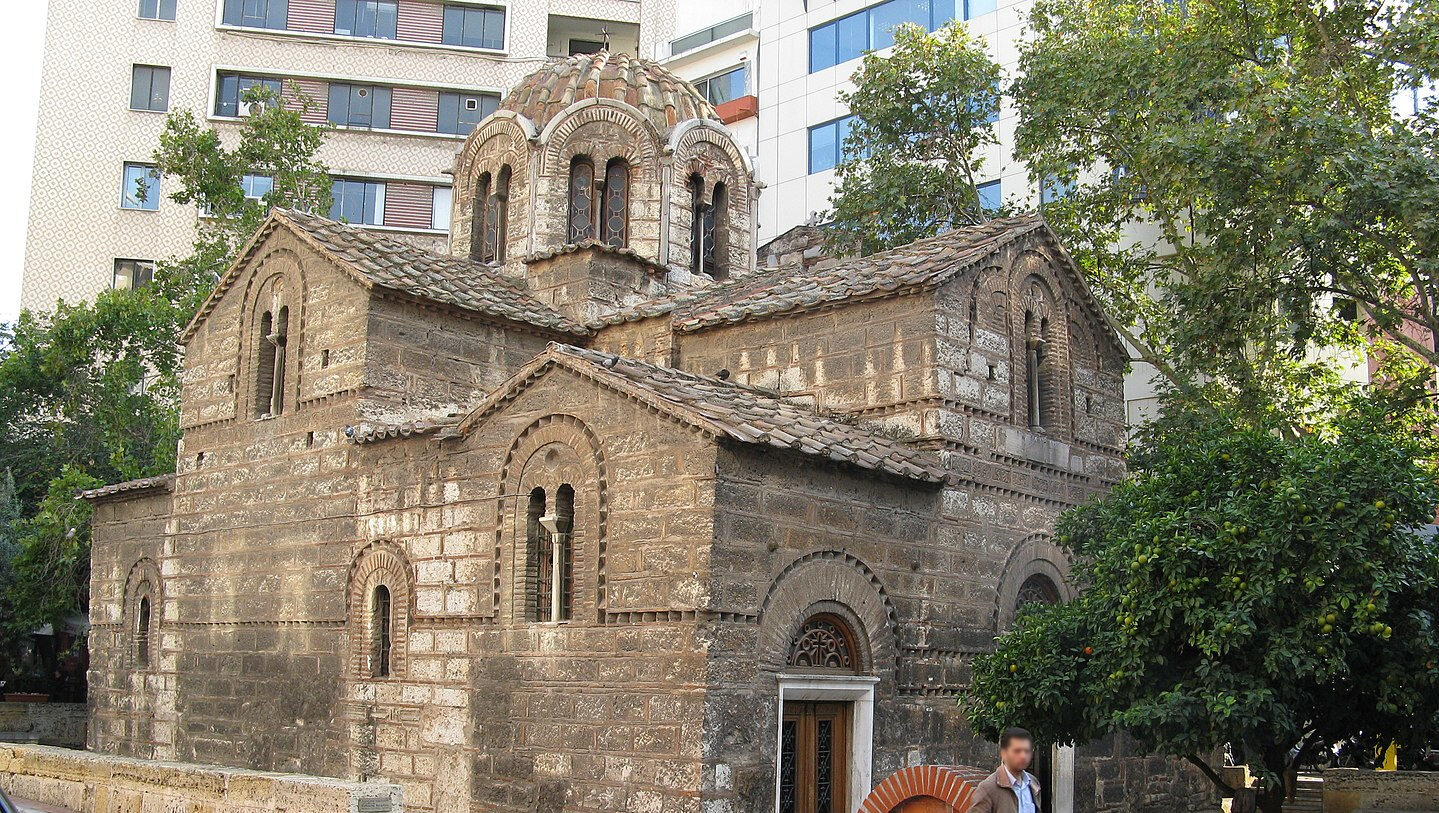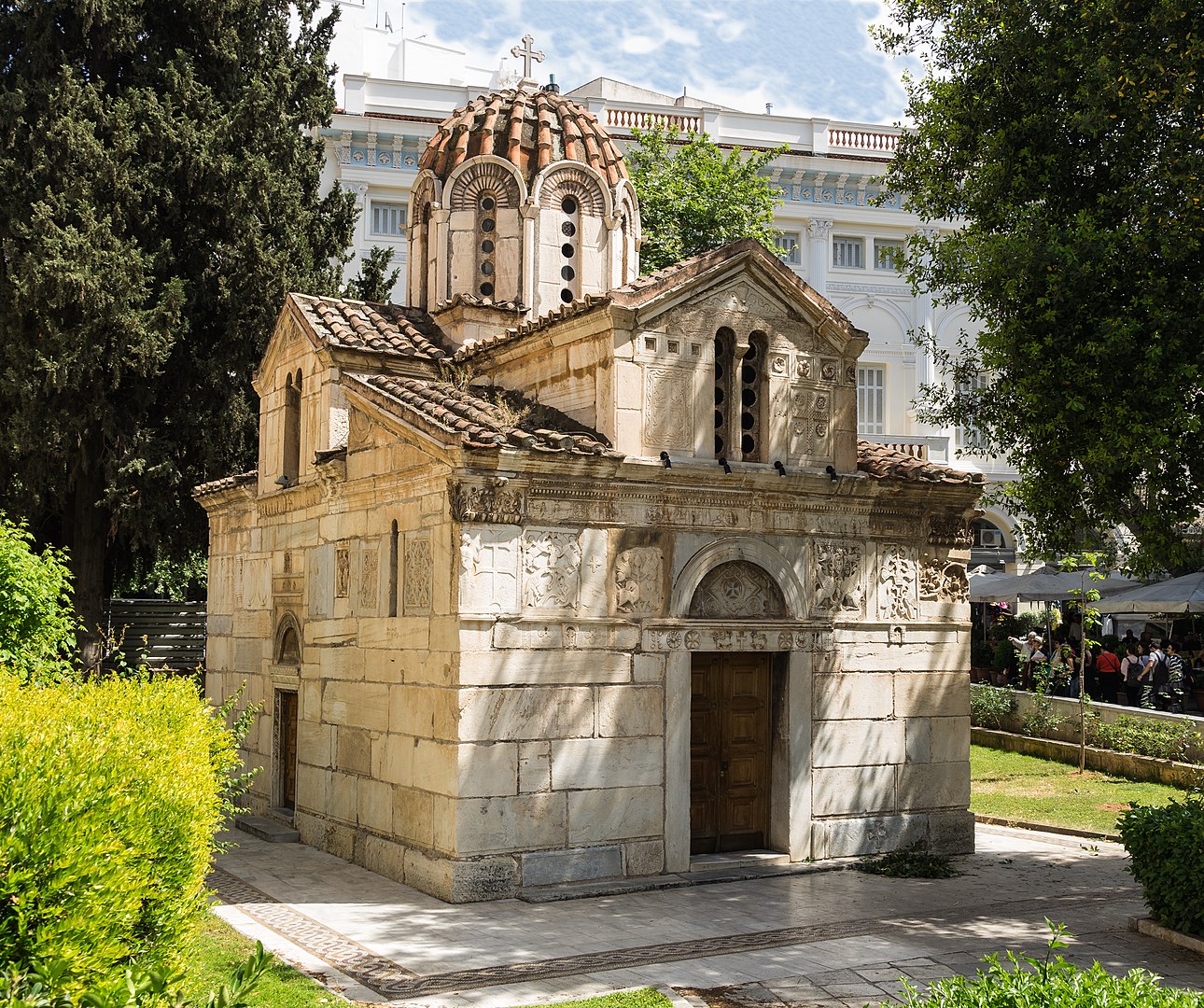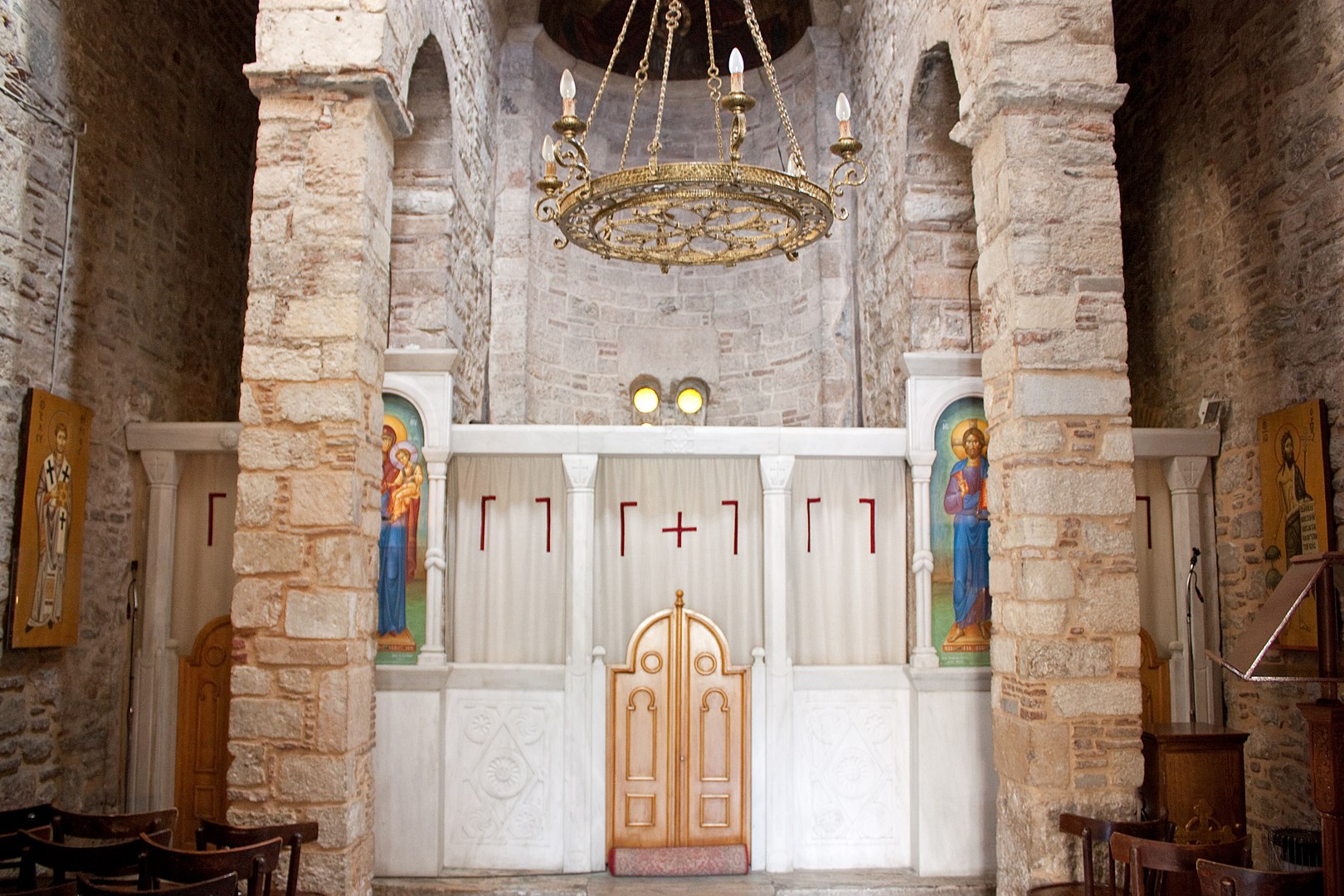Athens is packed with churches, in squares, in neighbourhoods, in groves, tucked away down the small alleys of Plaka, even in archaeological sites.
Some are small and humble and others are more majestic, both places of worship and historic buildings of particular architectural interest; the area under the Acropolis boasts some of the most remarkable and historic Byzantine churches, which mustn’t be overlooked to appreciate the cultural mosaic of the city. As is well known Athens is a multi-dimensional, attractive, safe destination offering unforgettable experiences throughout the year. Its Byzantine past still pulses strongly throughout the city and soaking up some of the mystique is truly eye-opening.
Agios Dimitrios Loubardiaris
This 12th century single-aisled, arched basilica is – not without reason- one of the most famous and beautiful churches of the city. Located at the foot of the hill of Filopappou, it has a special exterior decoration and is surrounded by tall pine trees. The paved path leading to the church is the work of architect Dimitris Pikionis, as well as the maintenance work carried out on the church in 1955. During its restoration, Pikionis removed the most recent frescoes to reveal the older ones, which date back to the 18th century and specifically, according to the inscription, to 1732. The date of its inauguration is inscribed on its built-in chancel. It bears the surname Loubardiaris or bombardier because, according to tradition, it was bombed during the Turkish occupation. On the eve of the saint’s feast day, many believers had gathered outside the church to celebrate his grace. Seeing the crowd, the Turkish garrison commander of the Acropolis, Yusuf-Agha, decided to bombard the temple with the big cannon of Loubarda, which was located in the Acropolis’ Propylaea, and, during the praise ceremony, aimed at St Demetrius. However, according to legend, God, with the help of the Saint, at the moment of firing, fired a bolt of lightning, destroying the cannons, killing the gunners, Yusuf-Agha and his family and thus saving the temple.
It is celebrated on 16 October. Opening hours: daily 08:00-12:00, Fri. 08:00-12:00 and 22:00-00:30. Filopappou Hill
Kapnikarea
Located in the middle of the shopping area of Ermou Street, the busiest pedestrian street of the capital, the church of Panagia Kapnikarea is not only a place of faith but also a meeting point. It is dedicated to the Presentation of the Virgin Mary and its humble beauty conceals a long history. It dates back to the end of the 11th century and in terms of architecture it belongs to the type of complex cross-in-square church with a dome which is supported by four Roman columns. Its name probably comes from the profession of the founder, a collector of the so-called “kapnikon” tax. In Byzantine times, a special tax was imposed on the smoke coming out of the chimneys of the houses in the area. The temple is said to have been built in sections in various periods and probably in three phases. Tradition claims that the present temple stands on the site of an older one built by Eudocia of Athens, wife of Emperor Theodosius II, who reigned from 408 to 450, who built it on the ruins of an ancient temple dedicated to the goddess Demeter or Athena, a practice that was very common at the time. The main church was probably built in the third quarter of the 11th century, the outer narthex and the front porch in the early 12th century, while the chapel of Agia Barbara was built either during Frankish (13th century-16th century) or the Ottoman rule. During the Greek Revolution of 1821, even the church of Kapnikarea did not remain intact during the siege of Athens, losing almost completely the chapel, which was later restored by Ioannis Prentzas at his own expense. During Otto’s reign, in the course of the works for the opening of Ermou Street, Kapnikarea was in danger of being demolished, but King Ludwig of Bavaria, Otto’s father (who reigned from 1832 to 1862), intervened and thus saved it. A few years later it was again threatened with demolition but was saved thanks to the Bishop of Athens Theophilos I Vlahopapadopoulos (1862-1873). It was built according to the architectural standards of the time, i.e. the brickwork system, which means carved stones surrounded by bricks.
On the outer walls, older stones have been placed in the shape of a cross, while ancient and early Christian sculptures have been incorporated into the decoration. The dome is of Athenian style with gutters in the shape of a lion’s head. Internally, the dome is supported by four columns of an earlier period, probably Roman, in a different style. In 1931, after the efforts of Professor Amilkas Alivizatos, the church became the property of the University of Athens to serve the worship needs of the students of the Theological School of Athens, while the frescoes inside the church date back to 1942 and are the work of the Greek artist Fotis Kontoglou and his students. The frescoes of the sanctuary and the dome are considered to be the work of Kontoglou himself, while the rest are attributed to his students.
It is celebrated on 21 November. Opening hours: weekdays, Sat. 11:00-17:00, Sun: 07:00-13:00. Pl. Kapnikareas – Ermou
Agios Nikolaos Ragavas
The church of Agios Nikolaos Ragavas is located at the foot of the Acropolis in Plaka, an area that in Byzantine times was considered one of the most aristocratic neighbourhoods. There is a theory that the church was originally erected in the 9th century and, like many churches in Greece, it was probably built on an ancient temple, as even today we can see an Ionic column incorporated into the northeastern side of the church, while the holy altar is supported by an inverted Corinthian column. However, this temple was destroyed for some unknown reason and was rebuilt in the 11th century, probably by the Ragavas family, hence its surname. The Byzantine emperor Michael I was a member of the family. Since then it has undergone many changes and extensions that have deprived the church of its Byzantine characteristics. In 1979, however, the archaeological service undertook its restoration, during which an invocatory inscription of a member of the Ragava family was discovered on one of the dome’s columns. We should also note that here, for the first time after 400 years of Ottoman occupation, the bell that marked the liberation of Athens was rung. This historic bell is a monument and is located inside the church. The original church, before the various changes and extensions, was a simple four-columned cruciform church with an octagonal Athenian-type dome. The masonry follows the type of brickwork system and is decorated with elements that imitate the Arabic script developed in the city of Kufa in Iraq, the so-called Kufic script.
It is celebrated on 6 December. Opening hours: weekdays 09:00:12:30, Saturday & Sunday 09:00:12:30 and possibly in the afternoon depending on whether they have a service. Prytaniou 1, Plaka
Agia Triada (The Holy Trinity)
Located high on Filellinon Street before the junction with Vasilissis Amalias Avenue, the architecture of Agia Triada stands out among the modern buildings of the Syntagma area and immediately attracts the eye with its imposing appearance. It belongs to the Byzantine monuments of the 11th century and used to be an Orthodox and then a Latin monastery. It’s a typical cross-in-square Byzantine church with a dome resting on an octagonal base, similar to the monastery of Osios Loukas in Boeotia (Viotia) region, with a brickwork masonry system. An inscription engraved on the inner south wall refers to the demise of Epifaneios Lykos and, thus, it is assumed that the church was called “The Virgin Saviouress of Lykodemos” in the past. According to other sources, the church was devoted to Saint Nikodemos and got the surname Lykodemos because it was built on the pre-existing temple of Apollo Lyceus. Originally it was a female, orthodox monastery but during the Frankish rule it was occupied by Benedictine monks until 1669 when it became again an orthodox, male monastery. The building of the monastery has been through a lot: in 1778 Hadji Ali Haseki, the Ottoman governor of Athens, demolished several of the cells to use the construction materials for the city wall, while during the revolution of 1821 the church was not spared either and suffered great damage. In 1847, however, the Russian ambassador requested that the church be given to the Russian community so that it could have its own place of worship, and so the restoration work began, with the costs being covered entirely by Russia. During the works, five metres below ground level, a covered reservoir was revealed that was probably part of the ancient Peisistrateio aqueduct, which supplied water to the baths of Admiral Nicodemus Street. The frescoes were carried out by German artist Ludwig Thiersch, who, having no experience in Orthodox iconography, is said to have given Apostle Paul the characteristics of King Otto. The church was consecrated in 1855 and dedicated to the Holy Trinity.
It is celebrated on the 50th day after Easter (a movable feast). Opening hours: daily 08:00-13:00, Friday and 19:00-12:30 (vigil). 21A, Filellinon Street, Athens
Holy Apostles Solaki
Located inside the archaeological site of the Ancient Agora, it is the only medieval monument in the area. If you visit the Agora do not ignore the quaint chapel of the Holy Apostles. It is a magnificent architectural example of Middle Byzantine ecclesiastical architecture, built at the end of the 10th century on an ancient monument of the 2nd century dedicated to the Nymphs. Its name was probably taken from the name of the Solakis family who owned the church during the Ottoman Empire. Combining a central-plan and a cross-in-square design, its masonry also follows the type of brickwork system, while in some parts it is decorated with pseudo-Kufic ceramic decorative elements. During the Greek War of Independence, like most of the monuments of the city, it was damaged, but in 1877 its restoration began, while at some point the church was extended and its original form was altered. Between 1954 and 1957 it was restored to its original Byzantine form. Inside, some frescoes of the 17th century and parts of the iconography that were transferred from temples that existed in the Ancient Agora and were demolished during the excavations are still preserved.
It is celebrated on 30 June. Opening hours: 08:00 – 18:00 (in summer), 08:00 -17:00 (in winter). Entrance: Andrianou 24, entrance fee: 10€, located within the archaeological site of the Ancient Agora. The church of Agioi Asomatoi/ Photo: Thaliapap- commons.wikimedia.org
Agioi Asomatoi
The church is a typical example of the Athenian Byzantine churches of the 11th century in the architectural style of a simple four-column cruciform with a narthex. Built of ashlar surrounded by bricks, it features large stones placed in the shape of a cross at its base. The dome belongs to the Athenian type with marble arches and small columns in the corners. We do not know much about its history, except that at the end of the 19th century, like many churches of its time, it underwent extensions for the needs of the faithful, which significantly altered its Byzantine character. However, in the years 1959-1960 it was restored to its original form. The main entrance is decorated with marble, while the exterior decoration is not lacking the characteristic Kufic elements. In an excavation next to the temple, fragments of three clay slabs with relief decoration were found, which were incorporated into the west side of the temple, as they were thought to belong to it.
It is celebrated on 7 November. Opening hours: 07:00 -12:00 & 17:30 – no specific closing time. Closed on Thurs. & Sun. afternoons. Ermou & Thermopylon 5
Agioi Theodoroi
It is located on the lower side of Klafthmonos Square and is one of the most important Byzantine monuments of the city. An inscription on the western wall of the church states that there was an earlier church on this site and that the new one was built by the military man Nikolaos Kalomalos. Another inscription mentions the date of construction of the temple, around the middle of the 11th century. During conservation work in the 1960s, sixteen tombs and a Roman mosaic floor were discovered, indicating that the church was also built on a Roman villa. Simple, two-column, cross-in-square church, the walls are built in the typical brickwork masonry and bear Kufic elements. During the Greek War of Independence it was damaged, but after the liberation it was repaired. Among the sponsors for its restoration were King Otto and his wife Amalia. The bell tower is of a later date, but parts of the original marble iconostasis have been found embedded in it.
It is celebrated on the first Saturday after Ash Monday (movable feast). Opening hours: weekdays 08:00 – 15:00, Sat. 09:00 -12:30, closed on Sundays. Agion Theodoron Square
Panagia Gorgoepikoos – Agios Eleftherios
It stands proudly next to the imposing Metropolis of Athens, having its own long and interesting history, and is also known as “the little Metropolis”. It dates back to the 12th century and is, unlike most Byzantine temples of its time, marble-built. Marble reliefs from monuments dating from the 6th century BC to the early Byzantine period were used as building materials. The church was built on top of an ancient temple dedicated to Eileithyia, the goddess of childbirth and labour pains. The church is dedicated to Panagia Gorgoepikoos, who – as her name suggests- hears the prayers of the faithful directly, but also to Agios Eleftherios. On the outside, on the west side of the temple, a frieze from an older building represents the Attic calendar of pre-Christian times. Part of the original frieze was cut off so that it could be incorporated into the temple, while in some parts crosses have been added to give it an Orthodox character. A total of 90 reliefs have been placed on the top of the temple, adding to its sheer beauty. The Athenian-type dome does not follow the type of brickwork system, but is made of rectangular marbles with some Kufic elements. In the churchyard, many years ago, tombstones were found, including those of the Benizelos family and their daughter Agia Filothei. The family home is just a few meters away from the temple. The gravestones were removed from the churchyard at the end of the 19th century. During its history, the church was used as an antiquities warehouse, as the city’s public library and as a chapel of the Metropolis. After a failed assassination attempt against King Otto in 1861, on the eve of Saint Sozon, it took the name of the saint at the request of Queen Amalia. In 1863, however, it was dedicated to Saint Eleftherios in the name of liberation from the Bavarians and Turks, but also because Saint Eleftherios is the patron saint of childbirth, like Eileithyia to whom the ancient temple there was dedicated.
It is celebrated on 28 October & 15 December. Opening hours: 10:00 – 18:00 daily. 8, Mitropoleos Square
*Attendance at churches should be done with due respect, decent clothing is recommended.



